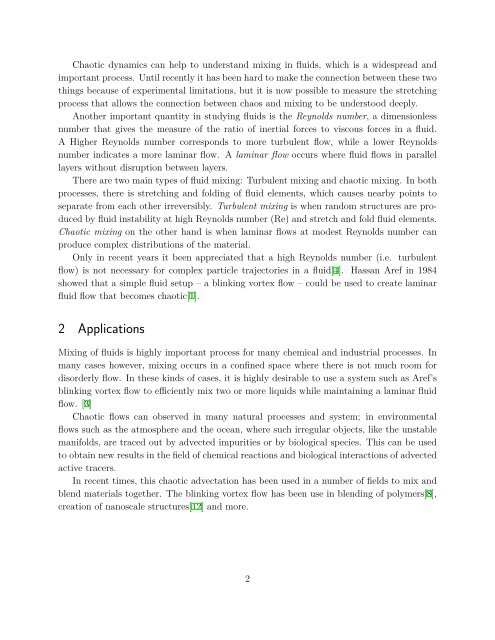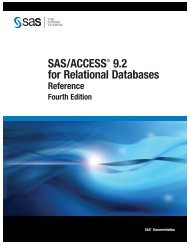Project paper - The Department of Physics and Astronomy
Project paper - The Department of Physics and Astronomy
Project paper - The Department of Physics and Astronomy
Create successful ePaper yourself
Turn your PDF publications into a flip-book with our unique Google optimized e-Paper software.
Chaotic dynamics can help to underst<strong>and</strong> mixing in fluids, which is a widespread <strong>and</strong>important process. Until recently it has been hard to make the connection between these twothings because <strong>of</strong> experimental limitations, but it is now possible to measure the stretchingprocess that allows the connection between chaos <strong>and</strong> mixing to be understood deeply.Another important quantity in studying fluids is the Reynolds number, a dimensionlessnumber that gives the measure <strong>of</strong> the ratio <strong>of</strong> inertial forces to viscous forces in a fluid.A Higher Reynolds number corresponds to more turbulent flow, while a lower Reynoldsnumber indicates a more laminar flow. A laminar flow occurs where fluid flows in parallellayers without disruption between layers.<strong>The</strong>re are two main types <strong>of</strong> fluid mixing: Turbulent mixing <strong>and</strong> chaotic mixing. In bothprocesses, there is stretching <strong>and</strong> folding <strong>of</strong> fluid elements, which causes nearby points toseparate from each other irreversibly. Turbulent mixing is when r<strong>and</strong>om structures are producedby fluid instability at high Reynolds number (Re) <strong>and</strong> stretch <strong>and</strong> fold fluid elements.Chaotic mixing on the other h<strong>and</strong> is when laminar flows at modest Reynolds number canproduce complex distributions <strong>of</strong> the material.Only in recent years it been appreciated that a high Reynolds number (i.e. turbulentflow) is not necessary for complex particle trajectories in a fluid[4]. Hassan Aref in 1984showed that a simple fluid setup – a blinking vortex flow – could be used to create laminarfluid flow that becomes chaotic[1].2 ApplicationsMixing <strong>of</strong> fluids is highly important process for many chemical <strong>and</strong> industrial processes. Inmany cases however, mixing occurs in a confined space where there is not much room fordisorderly flow. In these kinds <strong>of</strong> cases, it is highly desirable to use a system such as Aref’sblinking vortex flow to efficiently mix two or more liquids while maintaining a laminar fluidflow. [3]Chaotic flows can observed in many natural processes <strong>and</strong> system; in environmentalflows such as the atmosphere <strong>and</strong> the ocean, where such irregular objects, like the unstablemanifolds, are traced out by advected impurities or by biological species. This can be usedto obtain new results in the field <strong>of</strong> chemical reactions <strong>and</strong> biological interactions <strong>of</strong> advectedactive tracers.In recent times, this chaotic advectation has been used in a number <strong>of</strong> fields to mix <strong>and</strong>blend materials together. <strong>The</strong> blinking vortex flow has been use in blending <strong>of</strong> polymers[8],creation <strong>of</strong> nanoscale structures[12] <strong>and</strong> more.2
















